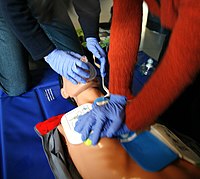
Photo from wikipedia
Introduction: Hyperventilation during cardiopulmonary resuscitation (CPR) negatively affects cardiopulmonary physiology. Compression-adjusted ventilations (CAVs) may allow providers to deliver ventilation rates more consistently than conventional ventilations (CVs). This study sought to… Click to show full abstract
Introduction: Hyperventilation during cardiopulmonary resuscitation (CPR) negatively affects cardiopulmonary physiology. Compression-adjusted ventilations (CAVs) may allow providers to deliver ventilation rates more consistently than conventional ventilations (CVs). This study sought to compare ventilation rates between these two methods during simulated cardiac arrest. Null Hypothesis: That CAV will not result in different rates than CV in simulated CPR with metronome-guided compressions. Methods: Volunteer Basic Life Support (BLS)-trained providers delivered bag-valve-mask (BVM) ventilations during simulated CPR with metronome-guided compressions at 100 beats/minute. For the first 4-minute interval, volunteers delivered CV. Volunteers were then instructed on how to perform CAV by delivering one breath, counting 12 compressions, and then delivering a subsequent breath. They then performed CAV for the second 4-minute interval. Ventilation rates were manually recorded. Minute-by-minute ventilation rates were compared between the techniques. Results: A total of 23 volunteers were enrolled with a median age of 36 years old and with a median of 14 years of experience. Median ventilation rates were consistently higher in the CV group versus the CAV group across all 1-minute segments: 13 vs 9, 12 vs 8, 12 vs 8, and 12 vs 8 for minutes one through four, respectively (P <.01, all). Hyperventilation (>10 breaths per minute) occurred 64% of the time intervals with CV versus one percent with CAV (P <.01). The proportion of time which hyperventilation occurred was also consistently higher in the CV group versus the CAV group across all 1-minute segments: 78% vs 4%, 61% vs 0%, 57% vs 0%, and 61% vs 0% for minutes one through four, respectively (P <.01, all). Conclusions: In this simulated model of cardiac arrest, CAV had more accurate ventilation rates and fewer episodes of hyperventilation compared with CV. Nikolla DA, Kramer BJ, Carlson JN. A cross-over trial comparing conventional to compression-adjusted ventilations with metronome-guided compressions. Prehosp Disaster Med. 2019;34(2):220–223
Journal Title: Prehospital and Disaster Medicine
Year Published: 2019
Link to full text (if available)
Share on Social Media: Sign Up to like & get
recommendations!